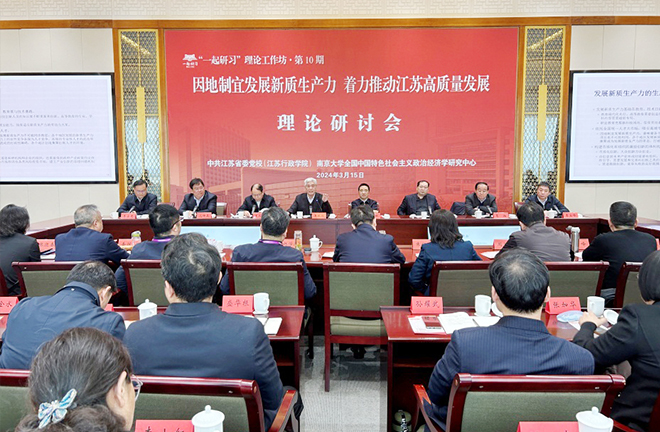Jiangsu builds up new quality productive forces

A seminar on new quality productive forces in Nanjing, Jiangsu Province, on March 15 Photo: Wu Nan/CSST
In mid-March, a seminar took place in Nanjing, Jiangsu Province, focusing on the cultivation of new quality productive forces (hereinafter referred to as NQPF) and the advancement of high-quality development. The primary objective was to gain insight into the important exposition by General Secretary of the CPC Central Committee Xi Jinping concerning the development of NQPF.
Attendees agreed that Xi’s elucidation of the concept of NQPF is both innovative and profound. His discourse not only represents a breakthrough in Marxist productivity theory but also an enrichment of Xi’s economic thought. This concept serves as a scientific compass for achieving high-quality development on the new journey, offering fundamental guidelines for Jiangsu to take the lead and set examples in the pursuit of Chinese modernization.
Conceptual connotations
New science and technology constitute the starting point for the development of NQPF, while new industries represent their destination. Innovation acts as the driving force in this process. Hong Yinxing, former Party secretary of Nanjing University (NJU) and a senior professor of humanities and social sciences, said that to accelerate the development of NQPF, the primary focus should be on exploring and expanding new tracks in technology, energy, and the digital economy.
In the view of Yang Ming, executive vice president of the Party School of CPC Jiangsu Committee, the introduction of NQPF reflects the transition of China’s economy from the accumulation of quantity to breakthroughs in quality, in alignment with the imperative to advance high-quality development and enrich the connotations of Xi Jinping Thought on Socialism with Chinese Characteristics for a New Era.
NQPF correspond to emerging industries with higher technology intensity and greater development potential, said Ge Yang, executive director of the National Research Center of Socialist Political Economy with Chinese Characteristics at NJU. Once attaining technological maturity and large-scale industrialization, emerging industries are likely to exhibit significantly higher R&D intensity, value-added rates, and enterprise return on investment compared to traditional industries. On the new journey of China’s modernization, the cultivation of NQPF can stimulate new momentum for high-quality development.
To build a modern industrial system, Hong suggested the extensive application of digital intelligence technology and green technology, transforming and upgrading traditional industries. This requires cultivating strategic emerging industries, which represent both the direction of scientific and technological innovation and the direction of industrial development. In addition, greater efforts are needed to advance the layout of biotechnology, green low-carbon, and other future industries. It is also advisable to deepen the integration of industries, universities, and research institutes, foster entrepreneurs in science and technology, and establish highland for innovation, instituting mechanisms that are compatible with NQPF through comprehensive reform.
Jiangsu’s conditions
Accelerating the development of NQPF is a major task entrusted to Jiangsu by General Secretary Xi Jinping. Jiangsu, boasting favorable conditions compared to other regions nationwide, possesses the capability to spearhead the cultivating of NQPF, Yang added.
Jiangsu is vigorously striving to develop NQPF tailored to its local conditions and build an industrial science and technology innovation hub with global influence, Ge noted. Efforts should be focused on the following aspects.
First, the province needs to construct a comprehensive innovation ecosystem, with particular efforts from industries, universities, and research institutes, as well as the financial field, thereby robustly forging strategic industrial clusters.
Second, strategic attention should be placed to the differentiated layout of key scientific and technological forces, centering on pivotal innovation domains such as quantum information, photonics, and micronanoelectronic technology.
The third aspect involves strengthening the role of enterprises as the main drivers of innovation, encouraging the formation of innovation consortia to undertake science and technology projects, supporting innovation integration among large, medium-sized, and small enterprises, and various other entities, with a focus on nurturing leading high-tech enterprises.
Deepening reforms in the scientific research system constitutes the fourth aspect. This will stimulate reforms of the management of research projects and the ownership of scientific and technological achievements, safeguarding the enthusiasm and creativity of scientists and researchers.
He Cong, head of the Jiangsu branch of the People’s Daily, said that Jiangsu is actively striving to walk at the forefront of the nation in accelerating the development of NQPF. The province is tailoring its efforts to leverage local endowments across the board, further unleashing the innovation vitality of new technology, new dynamics, and new energy sources, establishing a modern industrial system pillared by advanced manufacturing. At the practical level, the specific conditions of Jiangsu emphasize the importance of selecting industrial projects and cultivating innovation capabilities, since innovation represents Jiangsu’s comparative advantage and strength compared to other regions in the country.
The seminar was cohosted by the Party School of CPC Jiangsu Committee and the National Research Center of Socialist Political Economy with Chinese Characteristics at NJU.
Edited by YANG LANLAN
